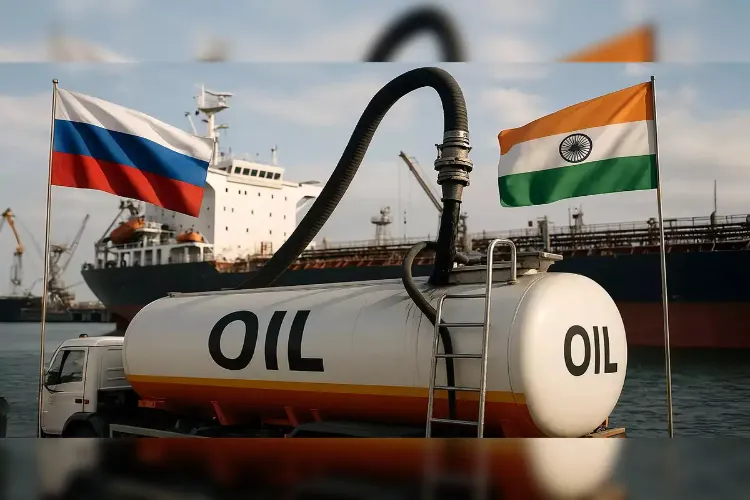
New Delhi
India's crude oil imports from Russia strengthened in the first half of October, reversing a three-month slide in arrivals seen during July-September as refineries were back on full stream to meet festive demand, according to ship tracking data.
Imports from Russia slid from over 2 million barrels per day in June to 1.6 million bpd in September.
However, tanker-tracking data for early October suggest a rebound: shipments of Urals and other Russian grades to India have picked up pace, supported by renewed discounts amid slack demand in Western markets and shipping flexibility.
Preliminary data by global trade analytics firm Kpler showed October imports tracking around 1.8 million barrels per day (bpd), an increase of around 250,000 bpd from the previous month (though the current month data is subject to revision).
The data pertains to the period prior to US President Donald Trump's October 15 statement claiming Prime Minister Narendra Modi has agreed to stop Russian crude imports. Ministry of External Affairs spokesperson Randhir Jaiswal, however, said he was not aware of such a phone conversation.
Sumit Ritolia, Lead Research Analyst (Refining & Modelling) at Kpler, believes Trump's statement was more likely pressure tactics linked to trade negotiations rather than a reflection of an imminent policy change.
"Russian barrels remain deeply embedded in India's energy system for economic, contractual, and strategic reasons," he said.
Indian refiners, too, said they have not yet been asked by the government to stop Russian oil imports.
India turned to purchasing Russian oil sold at a discount after Western countries imposed sanctions on Moscow and shunned its supplies over its invasion of Ukraine in February 2022. Consequently, from a mere 1.7 per cent share in total oil imports in 2019-20 (FY20), Russia's share increased to 40 per cent in 2023-24, making it the biggest oil supplier to India.
In the first half of October, Russia continued to enjoy that status. Iraq was the second biggest crude oil supplier to India at around 1.01 million bpd, followed by Saudi Arabia at 8,30,000 bpd. The US has overtaken the UAE to become India's fourth-largest supplier with 647,000 bpd. UAE supplied 394,000 bpd, according to Kpler.
Ritolia said Russian crude remains structurally vital for India, accounting for roughly 34 per cent of its total imports and offering compelling discounts that are too significant for refiners to ignore.
"There has been a lot of talk about the dip in imports during July-September. This was driven less by tariff concerns and more by seasonal factors, particularly increased maintenance activity at PSU refineries such as MRPL, CPCL, and BORL," he said.
In fact, most contracts for deliveries up to early September were finalised 6–10 weeks in advance, meaning deals were largely locked in before July 31. So dips in July-September were mostly due to refinery processing less crude in view of maintenance schedules.
Even with narrower discounts than in 2023, Russian barrels remain one of the most economical feedstock options available to Indian refiners, due to landed discounts and high GPW (Gross Product Worth) margin outputs from grades such as Urals.
Discounts average between USD 3.5-5 per barrel, up from USD 1.5-2 in July/August.
Replacing Russian crude is not difficult, as more barrels could flow from the Middle East, Latin America, and the US, similar to India's pre-2022 crude slate.
Indian refineries can handle diverse crude grades, so the technical constraint is minimal.
But whether New Delhi is ready to make that shift is another matter, he said. "The reality is that cutting Russian imports would be difficult, costly, and risky."
Substitution would require rapid scaling from multiple suppliers, at higher costs (freight, weaker discounts). If margins compress or retail prices rise, the result could be inflation, political backlash, and weaker refinery profitability.
He believes refiners won't leave a dollar on the table unless directed by the government - just as happened with Iranian barrels. While there has been a stronger push for diversification, contracts for Russian crudes are typically signed 6–10 weeks before arrival. Rewiring all that takes time. In practice, Indian refiners are gradually broadening their baskets, not to replace Russia in the short term, but to enhance energy security, continuity, and flexibility.
India has consistently pursued an independent foreign and energy policy, balancing economic interests with diplomatic relationships. A sudden shift away from Russian crude would undermine its energy security strategy and is unlikely unless formal sanctions — similar to those on Iran or Venezuela — are imposed.
"At this stage, it's improbable that India will implement structural cuts purely to satisfy US and EU political pressure. If Washington intensifies pressure, Indian refiners could make a token reduction - on the order of 100,000-200,000 bpd - to demonstrate diversification and appease Western partners. However, these cuts would likely be symbolic rather than transformative," he added.
Importing higher volumes from the US to placate Trump is an option, but the upside is capped at around 400,000-500,000 bpd. This is because US grades face both logistical disadvantages, economic and compatibility challenges with Indian refining systems.
READ MORE: Was the two-nation theory brainchild of Sir Syed Ahmad Khan?
Kpler data shows Indian imports of US crude have averaged 310,000 bpd so far in 2025, an increase from 199,000 bpd in 2024, hitting a yearly high of approx 500,000 bpd (Expected in October).
